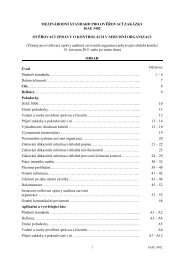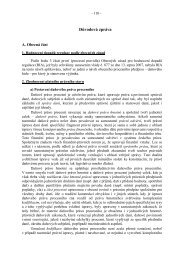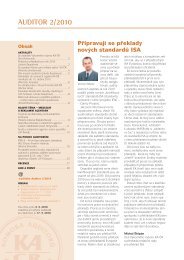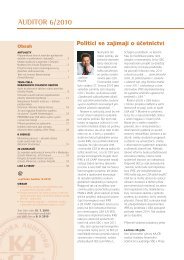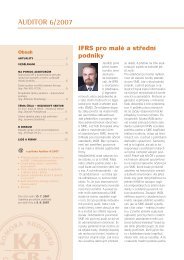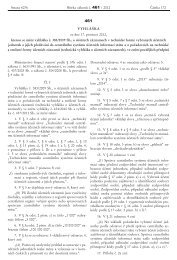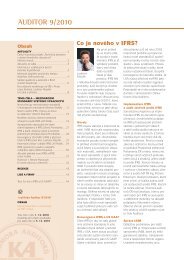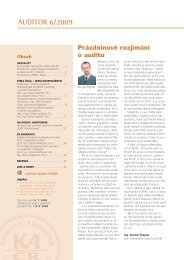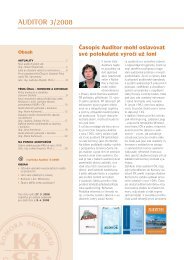Guide to Using International Standards on Auditing in - IFAC
Guide to Using International Standards on Auditing in - IFAC
Guide to Using International Standards on Auditing in - IFAC
Create successful ePaper yourself
Turn your PDF publications into a flip-book with our unique Google optimized e-Paper software.
57<br />
<str<strong>on</strong>g>Guide</str<strong>on</strong>g> <str<strong>on</strong>g>to</str<strong>on</strong>g> <str<strong>on</strong>g>Us<strong>in</strong>g</str<strong>on</strong>g> <str<strong>on</strong>g>Internati<strong>on</strong>al</str<strong>on</strong>g> <str<strong>on</strong>g>Standards</str<strong>on</strong>g> <strong>on</strong> <strong>Audit<strong>in</strong>g</strong> <strong>in</strong> the Audits of Small- and Medium-Sized Entities Volume 1—Core C<strong>on</strong>cepts<br />
• Identify the entity’s values, acceptable behaviors, and enforcement acti<strong>on</strong>s through discussi<strong>on</strong>s with<br />
management. The audi<str<strong>on</strong>g>to</str<strong>on</strong>g>r would then assess whether they are sufficient <str<strong>on</strong>g>to</str<strong>on</strong>g> address the c<strong>on</strong>trol design.<br />
• Ask <strong>on</strong>e or two employees what they believe are the entity’s values, acceptable behaviors, and<br />
enforcement acti<strong>on</strong>s. These <strong>in</strong>terviews would address whether management’s values and acceptable<br />
behaviors have been communicated and enforced. This would address c<strong>on</strong>trol implementati<strong>on</strong>.<br />
CONSIDER POINT<br />
Small entities are often reluctant <str<strong>on</strong>g>to</str<strong>on</strong>g> document <strong>in</strong>ternal c<strong>on</strong>trols which operate <strong>in</strong>formally. However,<br />
there can often be benefits <str<strong>on</strong>g>to</str<strong>on</strong>g> management <strong>in</strong> tak<strong>in</strong>g the time <str<strong>on</strong>g>to</str<strong>on</strong>g> document some of the more important<br />
policies and procedures. Such policies and procedures could be provided <str<strong>on</strong>g>to</str<strong>on</strong>g> staff jo<strong>in</strong><strong>in</strong>g the<br />
entity, and audit time may be saved versus hav<strong>in</strong>g <str<strong>on</strong>g>to</str<strong>on</strong>g> make <strong>in</strong>quiries each period. In the example cited<br />
above, even the smallest entity could prepare a simple statement of values and acceptable behaviors<br />
that could be provided <str<strong>on</strong>g>to</str<strong>on</strong>g> employees and then referred <str<strong>on</strong>g>to</str<strong>on</strong>g> when an issue arises.<br />
In smaller entities, some of the key areas <str<strong>on</strong>g>to</str<strong>on</strong>g> address <strong>in</strong> assess<strong>in</strong>g the c<strong>on</strong>trol envir<strong>on</strong>ment are outl<strong>in</strong>ed <strong>in</strong> the<br />
exhibit below.<br />
Exhibit 5.3-3<br />
C<strong>on</strong>trol Element The Key Questi<strong>on</strong> Possible C<strong>on</strong>trols<br />
Communicati<strong>on</strong><br />
and Enforcement<br />
of Integrity and<br />
Ethical Values<br />
Commitment <str<strong>on</strong>g>to</str<strong>on</strong>g><br />
Competence<br />
What management<br />
acti<strong>on</strong>s serve<br />
<str<strong>on</strong>g>to</str<strong>on</strong>g> elim<strong>in</strong>ate or<br />
mitigate <strong>in</strong>centives<br />
or temptati<strong>on</strong>s<br />
that might<br />
prompt pers<strong>on</strong>nel<br />
<str<strong>on</strong>g>to</str<strong>on</strong>g> engage <strong>in</strong><br />
dish<strong>on</strong>est, illegal,<br />
or unethical acts?<br />
Do pers<strong>on</strong>nel have<br />
the knowledge and<br />
skills necessary <str<strong>on</strong>g>to</str<strong>on</strong>g><br />
accomplish their<br />
tasks?<br />
• Management c<strong>on</strong>t<strong>in</strong>ually dem<strong>on</strong>strates, through words<br />
and acti<strong>on</strong>s, a commitment <str<strong>on</strong>g>to</str<strong>on</strong>g> high ethical standards.<br />
• Management removes or reduces <strong>in</strong>centives or<br />
temptati<strong>on</strong>s that might cause pers<strong>on</strong>nel <str<strong>on</strong>g>to</str<strong>on</strong>g> engage <strong>in</strong><br />
dish<strong>on</strong>est or unethical acts.<br />
• A code of c<strong>on</strong>duct or equivalent exists that sets out<br />
expected standards of ethical and moral behavior.<br />
• Employees clearly understand what behavior is<br />
acceptable and unacceptable, and know what <str<strong>on</strong>g>to</str<strong>on</strong>g> do when<br />
they encounter improper behavior.<br />
• Enforcement acti<strong>on</strong>s are taken when required.<br />
• Management takes the necessary steps <str<strong>on</strong>g>to</str<strong>on</strong>g> ensure that<br />
pers<strong>on</strong>nel have the requisite knowledge and skills<br />
required for their jobs.<br />
• Job descripti<strong>on</strong>s exist and are effectively used.<br />
• Management provides pers<strong>on</strong>nel with access <str<strong>on</strong>g>to</str<strong>on</strong>g> tra<strong>in</strong><strong>in</strong>g<br />
programs <strong>on</strong> relevant <str<strong>on</strong>g>to</str<strong>on</strong>g>pics.<br />
• Initial and <strong>on</strong>go<strong>in</strong>g match<strong>in</strong>g of staff skills <str<strong>on</strong>g>to</str<strong>on</strong>g> their job<br />
descripti<strong>on</strong>s.




